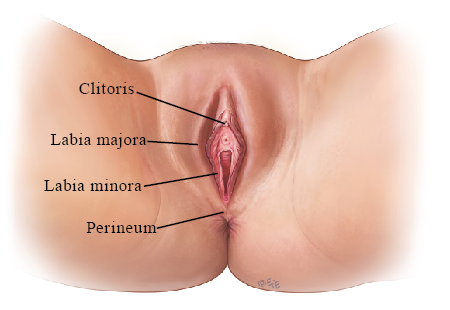Dyspareunia (Painful Sex)
In this Health Topic
The duration of the pain can be limited to the duration of intercourse but may last for up to 24 hours after intercourse has finished. The duration of symptoms varies widely and sometimes can be traced back to a specific time or event. It is often difficult to diagnose the exact source of discomfort (muscular, vascular, foreign bodies, surgery, trauma, aging, emotional) as well as to implement the correct treatment options.
Dyspareunia is common but probably under-reported. People experiencing sexual pain are encouraged to discuss it with their healthcare provider.
Several factors may contribute to the pain rather than one origin or cause. The factors contributing to sexual pain can include anatomic (body part) abnormalities, hormonal, as well as psychosomatic causes involving both the mind and body. Your healthcare provider will take a detailed history, assess your symptoms, and perform a detailed physical examination to reveal, if possible, the source or cause of the pain. Some of the conditions to consider are:
- Genitourinary syndrome of menopause (GSM). Changes in vaginal tissue due to lack of estrogen leading to tissue irritation, vaginal dryness and thinning can make intercourse quite uncomfortable and painful. It is important to note that up to 50% of people will experience some dyspareunia after menopause due to these tissue changes. They may experience a dry burning sensation due to lack of lubrication which may be associated with skin splitting, spotting or bleeding. Prolonged breastfeeding can produce similar changes and symptoms of vaginal dryness.
- Vulvodynia/Vestibulitis. This is a chronic localized pain syndrome of the vulva, labia, and vaginal opening. Causes include skin disorders that result in irritation (e.g., lichen sclerosus) and/or scarring of the vulvar tissue, trauma following surgery, childbirth, and more rarely, female circumcision or genital mutilation in some parts of the world. Radiation to the pelvic region can also cause nerve and tissue damage and lead to pain. Additionally, some people have intermittent discomfort which is difficult to reproduce.
- Bladder or urethral pain syndromes. There are several bladder pain syndromes which can cause chronic bladder and vaginal pain. These may not only cause dyspareunia, but also urgency, frequency of urination and pain with urination. These issues may start suddenly or occur gradually over a period of time and may be traced back to an event such as a previous infection. Additionally, certain disorders of the urethra (the tube through which urine is emptied from the bladder) can cause significant pain involving the vagina. Examples include urethritis (inflammation/pain in the urethra, sometimes caused by sexually transmitted diseases) and urethral diverticulum (a weakness in the wall of the urethra which forms a pocket in which urine can be trapped).
- Musculoskeletal issues. At times, people will describe a pain like being ‘stabbed in the vagina’ or ’hitting a wall’ sensation. This can be related to increased tension of the pelvic floor muscles so that they cannot properly relax. This phenomenon, called levator spasm, can cause constant or intermittent pain and is sometimes associated with other pain issues. This is seen sometimes in those with a history of sexual abuse. Additionally, some people have issues with rectal spasm and pain with an inability to properly relax muscles to have bowel movements and/or have intercourse.
- Pelvic inflammatory disease (PID). Often caused by sexually transmitted diseases, PID can cause chronic pain and dyspareunia as well. Irritable or inflammatory bowel diseases can also exacerbate dyspareunia and pelvic pain.
- Other pelvic conditions. Sometimes the definitive source of pain on examination is unclear, but there are other signs such as pain with menstrual cycles that is in excess to normal cramping. Conditions such as endometriosis or adenomyosis should be considered in these cases. Endometriosis is a condition in which glands inside the uterus, designed to bleed with the menstrual cycle, are instead found outside of the uterus, causing chronic cyclic pain and sometimes scarring. Adenomyosis is an overgrowth of glands inside the uterus, associated with heavy and painful menses and cyclical pelvic pain. Previous surgery causing scarring, tissue or nerve damage can also be a cause of painful intercourse.
- Local vaginal causes. Vaginal cyst, polyp, growth, foreign body, and sometimes relaxation of the pelvic organs which may cause a vaginal bulge (prolapse) may be the underlying cause of sexual discomfort. Vaginal surgery (with or without mesh) can also be a cause of pain. In rare cases, there may be an anatomic abnormality from birth such as a vaginal septum (piece of tissue dividing the vagina) which makes intercourse difficult or uncomfortable.
- Postpartum changes: Scarring and tenderness following an episiotomy or tear during childbirth is a common cause of dyspareunia. Also, if you are lactating, the decrease of estrogen levels in your body could affect the mucosa of your vagina in a similar way that it does after menopause. Some people experience burning, stinging pain in addition to vaginal dryness due to that decrease of estrogen even when using lubricants.
It is very important to give your physician a thorough and detailed description of the quality and timing of pain, the point during intercourse when pain begins, the duration of the pain, any change with the menstrual cycle (worsens or lessens), as well as all relevant childbirth, gynecology and bowel history. Any history of infections, whether pelvic, urinary, or vaginal is also important as well as addressing all previous surgeries.
While some vaginal pain may be related to levator muscle spasm, skin problems, and generalized vulva pain conditions (as described above), it is still important to investigate the underlying cause of the pain. Determining if the tissue is painful because of a sexually transmitted disease or other infections is important. Your physician will do a detailed sensory and physical examination to pinpoint the source of the pain. Depending on the findings of this examination, other tests may be ordered. Examples of tests that may be required include:
- Test for infection – swabs (vagina, cervix, urethra), urine sample
- Pelvic ultrasound
- CT scan/MRI of the pelvis
- Camera tests looking inside the womb (hysteroscopy), belly (laparoscopy), bladder (cystoscopy)
- Biofeedback
- Electromyography (muscle testing – this is not common)
Treatment options vary widely based on the underlying cause(s) of the pain being experienced. Any infection, whether vaginal, pelvic, or urinary should be properly treated. Low-dose vaginal estrogen is very useful in treating vaginal menopausal symptoms (see leaflet on low-dose vaginal estrogen therapy). The vaginal estrogen can be combined with lubricants (water-based, silicone-based, and/or oil-based) to provide adequate lubrication as well as advise about foreplay.
For vulvodynia and vestibulitis, the underlying cause must be determined. Dermatologic (skin) conditions leading to scarring and inflammation can often be treated with steroid or hormonal creams. Vulva lichen sclerosus is a common example of a skin condition that can be treated easily with steroid creams. Local cream applications, vaginal dilators and, in some instances, laser therapy, can help alleviate vulvar skin symptoms. Trigger point injections may also provide some relief as can biofeedback and physical therapy. Your doctor can also prescribe medications that help reduce nerve irritation and pain as well. When to use multiple treatments is a decision made by the individual healthcare provider.
For bladder pain leading to dyspareunia, treatment generally begins with eliminating irritants such as caffeine and cigarettes from the diet (see leaflet on interstitial cystitis) and physical therapy. There are also a variety of medications that can be used, although not everyone responds to the same regimen. Instillations of a medication ‘cocktail’ in the bladder is also used as an adjunct to therapy. If the underlying issue is the urethra, treatment may be medication or surgery depending on if the underlying cause is infection or a physical defect with the urethra itself.
Musculoskeletal issues with pelvic floor muscle spasm (levator spasm) may be treated with meditative techniques, physical therapy (including massage, heat, biofeedback with a therapist trained in pelvic floor problems), counseling, trigger point injections of anesthetic and/or steroids into the trouble spots or Botox injection to relax the muscle, as well as using vaginal dilators. Pain that is resistant to multiple treatments may be a different neurologic type of pain which requires a nerve block.
Dyspareunia caused by pelvic pain due to endometriosis or adenomyosis can be initially suppressed with continuous hormone therapy as fluctuations in hormones can exacerbate pain. Examples of such hormonal treatment are taking the contraceptive pill continuously or the Mirena coil system. Hormone blocking injections are also an option but have some side effects which your doctor will explain to you. If still unsuccessful, removal of the ovaries (if endometriosis is the cause) or the uterus (if adenomyosis is the cause) may be the last resort. Removal is generally a last resort in the absence of other pathology. Your doctor may refer you to another specialist if he/she believes the pain is related to your bowel or other area.
If found, local causes in the vagina, e.g., vaginal cyst, can be removed. Removal of vulva/vaginal scar tissue or a vaginal mesh sling if causing pain can be done by specialist doctors with experience in these procedures. In people with spasm of the muscles at the entrance to the vagina (perineal muscles) e.g., following childbirth trauma, sexual assault or rape, Botox injection into the muscle has been found to be very useful as it relaxes the muscle and makes intercourse less painful. Sexual discomfort due to pelvic organ prolapse (descent of the pelvic floor leading to a bulge in the vagina) should be evaluated by a urogynecology specialist or other healthcare provider and either corrected surgically or supported with a vaginal insert called a pessary (see leaflets on pelvic organ prolapse and vaginal pessary for pelvic organ prolapse).
Finally, it is important to stress that dyspareunia can be a chronic and frustrating condition that may require multiple visits, and treatment involving various specialists in order to adequately manage it. Your doctor will advise you about this.

